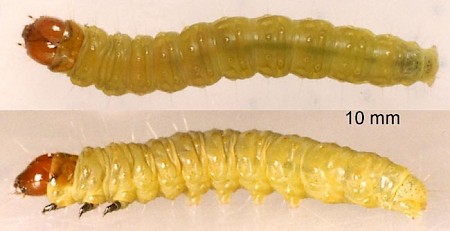Rhomboid Tortrix Acleris rhombana

49.07 BF1042
Rhomboid Tortrix Acleris rhombana
([Denis & Schiffermüller], 1775)
Wingspan 13-19 mm.
With the slightly hooked tips and reticulated pattern of the forewings, this species is fairly easy to identify, despite being rather variable.
It can often be found around hedgerows and gardens, the foodplants being a range of trees and shrubs including hawthorn (Crataegus), and is quite common throughout Britain.
The adults fly in autumn, from August to October, and are nocturnal.
Larva: (description Ian F. Smith)
Foodplant: April to June. Early on buds, later in spun terminal leaves or flowers of Crataegus,Prunus, Malus, Pyrus, Rosa, and sometimes, Corylus, Sorbus or Quercus.
Early instar
Head and prothoracic plate black (Bradley, Tremewan and Smith).
Late instar
Length: Described specimen 10 mm. Grows to 14 or 16 mm (Aizpurua).
Head: Reddish brown. Frons and labrum darker. Clypeus transparent whitish.
Posterior of capsule thinly edged black. Stemmatal area black.
Prothoracic shield: Transparent greenish brown, with darker brown laterally and along posterior edge. Divided by green medial line. Shield sometimes
yellow-brown or green, (Bradley, Tremewan and Smith).
Thoracic legs: Coxa and trochanter concolorous with body, with black marks. Femur, tibia and tarsus black.
Body: Translucent yellowish green. Dorsally; slightly shagreened and darker. Contractile dorsal vessel may show as indistinct dorsal line, and viscera may give slight reddish tinge.
Spiracles: Peritreme light brown.
Pinacula: Shiny and slightly paler than integument. Small brown setal spot.
Setae: Translucent. Basally pale brown, fading to whitish distally.
Anal plate: Coloured as abdomen, with transparent marks revealing darker viscera.
Prolegs: Coloured as abdomen. Crochets reddish brown, arranged in double concentric circles. Anal comb translucent light brown with about 6 prongs.

 UKMoths
UKMoths 




